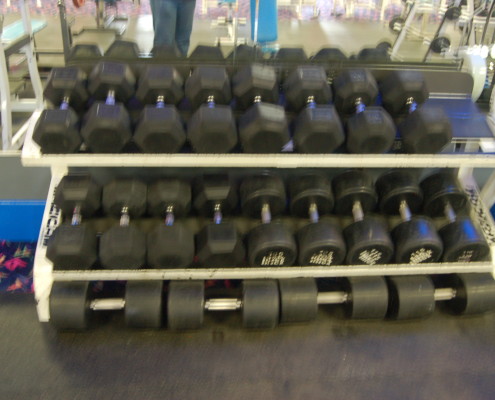Don’t Skip the Free Weights!
 Finally! You buckled down and signed up for a gym membership. You strap on your tennis shoes and get a good stretch in. Once you enter the gym though you feel overwhelmed by all the equipment and weights. The only thing that looks familiar is the treadmill so you resort to jogging lazily for a half hour before you decide the coast is clear to sneak out. If you’re new to the gym and feeling a little apprehensive about trying weight training for the first time, you may want to start with free weights.
Finally! You buckled down and signed up for a gym membership. You strap on your tennis shoes and get a good stretch in. Once you enter the gym though you feel overwhelmed by all the equipment and weights. The only thing that looks familiar is the treadmill so you resort to jogging lazily for a half hour before you decide the coast is clear to sneak out. If you’re new to the gym and feeling a little apprehensive about trying weight training for the first time, you may want to start with free weights.
Using free weights such as dumbbells have amazing benefits and are a great addition to a regular cardio routine. They are some of the most popular workout equipment because of their versatility and targets specific muscle groups all while improving your stabilizing muscles. You won’t regret stepping up to the weight rack and attempting some simple dumbbell workouts to test your strength. It may take some time and experimenting, but everyone can find a free weight routine that will work for them.
Dumbbells are the most versatile piece of equipment in any weight room or gym. You can find at least 70 different exercises to do with just one dumbbell. This one piece of simple equipment will allow you to target all major muscle groups in your body, which is what you will want to achieve with any weight training routine.
Free weights are beneficial to your workout routine because they target your stabilizing muscles. Most dumbbell exercises are done in a standing position, working one side of your body at a time. This helps the smaller muscle groups that help with balance and coordination grow with your larger muscle groups, achieving a more total body workout by the time you’re done. Utilizing your gym’s dumbbell system with consistency will help you tone and build muscle, depending on what your fitness goals are.
A common mistake when using free weights is cheating. It is very tempting to swing your upper body when doing arm exercises with free weights, which is helping you lift the weight, but it not helping your biceps gain muscle. Be sure to keep good posture when doing any free weight exercises. This will help with balance and keep you working the muscles you are targeting with each individual exercise.
Practice caution when beginning your free weight regimen. Take the time to experiment with the right amount of weight for your current muscle strength. You can always do more reps or use heavier weights once you’ve built up your routine. To avoid injury, take your first free weight sessions slow, focusing on your posture and doing the exercise correctly versus lifting the maximum amount of weight you can handle. Consult a physician if you think you may have pulled a muscle or injured yourself in any way while exercising.
